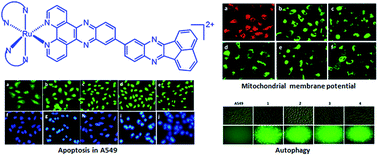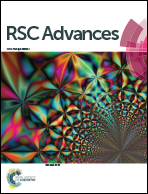Apoptosis, autophagy, cell cycle arrest, cell invasion and BSA-binding studies in vitro of ruthenium(ii) polypyridyl complexes†
Abstract
Ruthenium(II) polypyridyl complexes show high anticancer activity, and can induce apoptosis. Herein, a new ligand AQTP (AQTP = 12-acenaphtho[1,2-b]quinoxalin-9-yl-4,5,9,14-tetraazabenzo[b]triphenylene) and its four ruthenium(II) polypyridyl complexes [Ru(N-N)2(AQTP)](ClO4)2 (N-N = dmb: 4,4′-dimethyl-2,2′-bipyridine 1; bpy: 2,2′-bipyridine 2; phen: 1,10-phenanthroline 3 and dmp: 2,9-dimethyl-1,10-phenanthroline 4) were synthesized and characterized. The cytotoxic activity in vitro of the complexes against BEL-7402, A549, HeLa, HepG2, MG-63 and normal cell HLF was investigated using the MTT method (MTT = (3-(4,5-dimethylthiazol-2-yl)-2,5-diphenyltetrazolium bromide)). The apoptosis was assayed with AO/EB and Hoechst 33258 staining methods. The ROS, mitochondrial membrane potential and autophagy were studied using a fluorescent microscope. The expression of caspases and Bcl-2 family proteins was investigated by western blot analysis. The IC50 values of complexes 1–4 toward A549 cells are 5.0 ± 0.8, 10.0 ± 0.7, 45.0 ± 1.4 and 3.8 ± 0.1 μM. The complexes can increase the levels of reactive oxygen species (ROS), and induce a decrease in the mitochondrial membrane potential. Complexes 1–4 inhibit cell growth at the G0/G1 phase in A549 cells, and the complexes can induce both autophagy and apoptosis, and the complexes induce apoptosis through a ROS-mediated mitochondrial dysfunction pathway.


 Please wait while we load your content...
Please wait while we load your content...